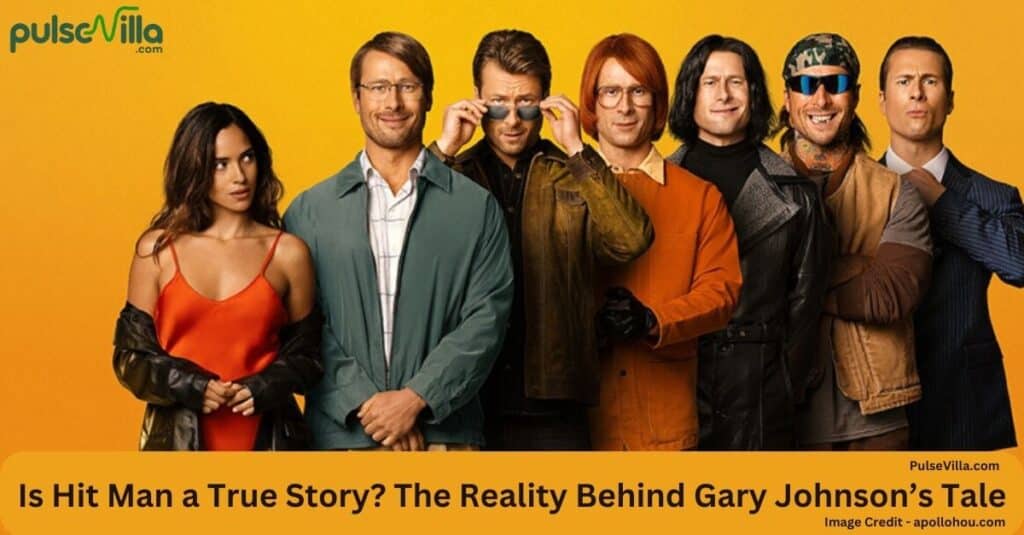In the shadowy world of undercover police work, few stories captivate the public imagination quite like that of Gary Johnson. His tale, recently brought to life in Richard Linklater’s Netflix film “Hit Man,” blurs the lines between fact and fiction, leaving audiences wondering: Is Hit Man a true story? Let’s dive deep into the reality behind Gary Johnson’s incredible journey from a humble sheriff’s deputy to a master of disguise who infiltrated Houston’s criminal underworld.

Image Credit – collider.com
You may also find this interesting “Andrea Canning Net Worth, Age, Height, Career, etc.”
The Man Behind the Myth: Who Was Gary Johnson?
Gary Johnson’s path to becoming an undercover legend began far from the glitz of Hollywood. Born and raised in Texas, Johnson’s early life was marked by a strong sense of justice and a knack for adapting to different situations. These traits would later prove invaluable in his career as an undercover operative.
From Sheriff’s Deputy to Undercover Maven
Johnson’s law enforcement career started conventionally enough. He joined the Houston Police Department as a young man, eager to make a difference. But it was his unique approach to police work that set him apart. Unlike many of his colleagues, Johnson had an uncanny ability to blend into any environment, a skill that caught the eye of his superiors.
“Gary had this chameleon-like quality,” recalls former HPD Chief Sam Houston (not to be confused with the historical figure). “He could walk into a room full of strangers and within minutes, you’d think he’d known them for years.”
This ability didn’t go unnoticed. As Houston grappled with rising crime rates in the 1970s and ’80s, the department was on the lookout for innovative ways to combat criminal organizations. Johnson’s talents made him the perfect candidate for undercover work.
Key Traits of an Undercover Ace
What made Gary Johnson so effective in his role? Let’s break down the essential qualities that turned a regular cop into an undercover sensation:
- Adaptability: Johnson could seamlessly adjust his persona to fit any scenario.
- Quick thinking: He had a talent for improvising when situations took unexpected turns.
- Emotional intelligence: Understanding and manipulating the emotions of others was crucial to his success.
- Attention to detail: Johnson’s meticulous approach helped him maintain complex cover stories.
- Physical versatility: He could alter his appearance dramatically, from a suave businessman to a rough-and-tumble biker.
These traits, combined with rigorous training and a deep commitment to justice, formed the foundation of Johnson’s extraordinary career.

Image Credit – imdb.com
You might find this worth exploring as well “Miss Alabama Pageant Winner Is Plus-Sized, Miss Maryland Winner Is A Transgender Woman.”
The Birth of the “Hit Man” Persona
The transformation of Gary Johnson from a regular police officer to the infamous “Hit Man” didn’t happen overnight. It was a gradual process, born out of necessity and honed through experience.
Crafting an Alter Ego
Johnson’s journey into the world of faux hit men began with a simple observation: criminals often sought out professional killers for their dirty work. Recognizing this as a potential in-road to major criminal operations, Johnson and his superiors devised a bold plan.
They would create an alter ego for Johnson – a professional hitman with a reputation for discretion and efficiency. This persona would be their ticket into the heart of Houston’s criminal underbelly.
Building a Believable Backstory
To make his hit man persona believable, Johnson didn’t just change his appearance. He crafted an entire life story:
- Name: Various aliases, including the memorable “Jim Broadwell”
- Background: Ex-military operative with experience in covert operations
- Skills: Proficient in various weapons and hand-to-hand combat
- Personality: Cool, calculating, and strictly business-oriented
Johnson went to great lengths to authenticate his cover. He studied real hitmen, their methods, and their mannerisms. He even took classes in drama and method acting to perfect his performance.

Image Credit – Collider.com
You may also want to discover more about this “Maxton Hall: The World Between Us Now Streaming on Amazon Prime Video – Discover the Cast and Plot Details.”
First Major Operations
Johnson’s first foray as the “Hit Man” was a nerve-wracking experience. The stakes were high – one wrong move could blow his cover or, worse, cost him his life. But Johnson’s meticulous preparation paid off.
His initial operations targeted smaller criminal groups, allowing him to build a reputation within the underworld. Word spread quickly about the new hitman in town who could get the job done without leaving a trace.
| Year | Operation | Outcome |
| 1983 | Operation Nighthawk | 3 arrests, drug ring disrupted |
| 1985 | Sting 85 | 7 arrests, including a local crime boss |
| 1987 | Project Shadowfall | 12 arrests, weapons trafficking ring dismantled |
These early successes not only validated the “Hit Man” strategy but also provided valuable insights that would shape future undercover operations.
Fact vs. Fiction: Separating Truth from Hollywood Drama
Richard Linklater’s “Hit Man,” starring Glen Powell, has brought Gary Johnson’s story to a whole new audience. But as with any Hollywood adaptation, the line between fact and fiction can become blurred. Let’s examine some key elements of the film and compare them to the real events.
The Love Story: Did It Really Happen?
One of the most captivating aspects of the Netflix film is the love story between Gary (portrayed by Glen Powell) and Madison, a woman who hires him to kill her abusive boyfriend. In reality, this romantic subplot is largely a product of Hollywood’s creative license.
- Film: Gary falls for Madison, complicating his undercover work.
- Reality: Johnson maintained strict professional boundaries during his operations.
While the real Gary Johnson did encounter individuals seeking to hire a hitman for personal reasons, there’s no evidence of a romantic entanglement like the one portrayed in the movie.

Image Credit – reason.com
You might also enjoy learning about this “Avengers: Doomsday Release Date, Cast, and Plot and more.”
The Art of Disguise: How Accurate Was It?
The film showcases Gary’s incredible ability to transform himself using various disguises. This aspect of the story is rooted in truth but somewhat exaggerated for dramatic effect.
Film portrayal:
- Elaborate costume changes
- Dramatic personality shifts
- Instant transformations
Real-life tactics:
- Subtle appearance alterations
- Consistent persona development
- Gradual character evolution
Johnson was indeed a master of disguise, but his methods were often more nuanced than the film suggests. He relied on small changes in appearance combined with well-practiced behavioral shifts to maintain his cover.
Sting Operations: Hollywood vs. Reality
The movie depicts several high-stakes sting operations, often resolved in dramatic, action-packed sequences. While Johnson did participate in numerous successful stings, the reality was often more methodical and less cinematic.
Movie sting operations:
- Fast-paced and action-packed
- Resolved in a single encounter
- Often involve violence or threats
Real-life sting operations:
- Carefully planned over weeks or months
- Multiple meetings and evidence gathering
- Emphasis on legal compliance and safety
“Our operations were more like chess games than action movies,” Johnson once remarked in a rare interview. “Every move was calculated, and patience was our greatest weapon.”

Image Credit – screenrant.com
This may also be of interest to you “Meet the Cast of Thanksgiving, the Horror Hit of 2023.”
The Art of Deception: Johnson’s Undercover Techniques
Gary Johnson’s success as an undercover operative wasn’t just about playing a role. It was about becoming someone else entirely. His techniques for deception went far beyond simple disguises, involving a complex interplay of psychology, improvisation, and meticulous planning.
Master of Disguise: Johnson’s Transformation Methods
Johnson’s ability to transform himself was legendary within the Houston Police Department. Here’s a breakdown of his key disguise techniques:
- Physical Alterations:
- Hair and makeup changes
- Prosthetic additions (noses, scars, etc.)
- Weight fluctuations (gained or lost for specific roles)
- Wardrobe Choices:
- Extensive collection of clothing for different personas
- Attention to details like wear patterns and brand choices
- Behavioral Shifts:
- Adopted different accents and speech patterns
- Altered body language and mannerisms
- Developed unique habits for each character
- Backstory Development:
- Created detailed life histories for each persona
- Memorized specific details to maintain consistency
Johnson’s transformations were so complete that even colleagues sometimes failed to recognize him when he was in character.
Building Credibility in the Criminal Underworld
Appearing the part was only half the battle. To truly infiltrate criminal groups, Johnson had to establish a reputation within the underworld. His methods included:
- Staged Encounters: Orchestrating “chance” meetings with known criminals
- Word-of-Mouth Marketing: Using informants to spread rumors about his skills
- Controlled Information Leaks: Strategically releasing information about his “past jobs”
- Demonstrable Skills: Showcasing abilities that would impress criminals (e.g., marksmanship, lock-picking)
These tactics helped Johnson build a network of contacts and a fearsome reputation that opened doors to high-level criminal operations.

Image Credit – screenrant.com
You might want to explore this as well “Exploring the Cast of The Little Mermaid (2023): A Dive into the Live-Action Remake’s Characters.”
Psychological Tactics Used to Gain Trust
Johnson’s success hinged on his ability to manipulate the psychology of his targets. Some of his key tactics included:
- Mirroring: Subtly mimicking the body language and speech patterns of his targets
- Controlled Vulnerability: Sharing carefully crafted “personal information” to create a sense of intimacy
- Reciprocity: Doing small favors to encourage targets to reciprocate with trust
- Scarcity: Presenting himself as an exclusive, hard-to-access resource
- Social Proof: Leveraging his reputation and connections to validate his credibility
By employing these psychological techniques, Johnson was able to forge deep connections with his targets, often becoming a trusted confidant in a remarkably short time.
High-Stakes Operations: Johnson’s Most Daring Cases
Throughout his career, Gary Johnson participated in numerous high-profile operations that dismantled major criminal networks and saved lives. While many details remain classified, some of his most notable cases have become the stuff of law enforcement legend.
Operation Thunderbolt (1989)
Objective: Infiltrate a international weapons trafficking ring operating out of Houston.
Duration: 8 months
Challenges:
- Multiple layers of criminal hierarchy to penetrate
- Constant threat of exposure
- International travel required
Outcome:
- 23 arrests across three countries
- Seizure of over $50 million in illegal weapons
- Disruption of supply lines to several terrorist organizations
Johnson’s role as a weapons expert and hitman was crucial in gaining the trust of the ring’s leadership. His ability to demonstrate technical knowledge while maintaining his cover was particularly praised by his superiors.
You could be curious about this too “Who is McKenna Faith Breinholt?: Meet the Arizona’s Rising ‘American Idol’ Star.”
The Venomous Sting (1992)
Objective: Take down a drug cartel responsible for a new, lethal synthetic opioid flooding Houston’s streets.
Duration: 14 months
Challenges:
- Extremely violent cartel members
- Required deep cover with minimal contact with handlers
- Pressure to act quickly due to mounting overdose deaths
Outcome:
- Arrest of cartel’s entire leadership structure
- Seizure of over 200 kg of synthetic opioids
- Dismantling of three major drug labs
This operation pushed Johnson to his limits, requiring him to maintain his cover for extended periods with little support. His ability to adapt and think on his feet saved his life on multiple occasions.
Project Looking Glass (1995)
Objective: Expose corruption within local government and law enforcement.
Duration: 18 months
Challenges:
- High risk of exposure due to targets’ law enforcement connections
- Ethical dilemmas of investigating fellow officers
- Complex web of relationships and loyalties to navigate
Outcome:
- Arrest of two city council members and three high-ranking police officials
- Exposure of a multi-million dollar bribery and extortion scheme
- Comprehensive reform of department policies and procedures
This operation was particularly challenging for Johnson, as it required him to potentially betray the trust of fellow officers. His unwavering commitment to justice and meticulous approach were crucial to the operation’s success.
These high-stakes operations not only showcased Johnson’s exceptional skills but also had far-reaching impacts on criminal activities in Houston and beyond. They cemented his reputation as one of the most effective undercover operatives in modern law enforcement history.
Post Credit – Pinterest.com
This might also pique your interest “Mark Singer Gorilla Glue Net Worth 2024 Revealed and Explored.”
Ethical Dilemmas and Legal Challenges
The world of undercover work is fraught with moral ambiguities and legal complexities. Gary Johnson’s career, while undoubtedly successful, raised numerous ethical questions and legal challenges that continue to be debated in law enforcement circles today.
Walking the Line: Law Enforcement vs. Criminal Behavior
One of the most significant challenges Johnson faced was maintaining his cover without crossing legal and ethical boundaries. As a faux hit man, he often found himself in situations where he had to convince criminals of his willingness to commit violent acts.
Ethical Concerns:
- How far is too far when pretending to be a criminal?
- Does participating in criminal planning (even without intent to follow through) constitute a crime?
- What are the psychological effects of long-term immersion in criminal mindsets?
Johnson developed a set of personal guidelines to navigate these murky waters:
- Never actually commit a violent act or serious crime
- Always have a plan to prevent harm if a situation escalates
- Maintain constant communication with handlers about ethical concerns
- Regularly reevaluate the moral cost vs. benefit of each operation

Image Credit – netflix.com
You may want to check this out too “Who is LaMelo Ball Dating? Inside the Relationship of the NBA Star LaMelo Ball and Ana Montana”
The Entrapment Controversy
Perhaps the most contentious aspect of Johnson’s work was the issue of entrapment. Critics argued that by posing as a hitman, Johnson was essentially creating opportunities for crime that wouldn’t otherwise exist.
Legal Definition of Entrapment: Entrapment occurs when law enforcement induces a person to commit a crime they would not have otherwise committed.
Johnson and his defenders argued that his operations didn’t constitute entrapment because:
- He never initiated contact or suggested criminal activities
- Targets always approached him with criminal intent already formed
- He gave targets multiple opportunities to back out
Despite these arguments, several cases resulting from Johnson’s operations faced legal challenges on entrapment grounds. While most were ultimately upheld, they sparked ongoing debates about the tactics used in undercover operations.
Debates Within Law Enforcement
Johnson’s methods were not universally accepted within the law enforcement community. His approach sparked heated discussions about the appropriate limits of undercover work.
Arguments in Favor:
- Effectiveness in taking down major criminal organizations
- Ability to prevent crimes before they occur
- Gathering of high-quality intelligence
Arguments Against:
- Potential for abuse and corruption
- Risk of psychological damage to officers
- Erosion of public trust in law enforcement
These debates led to the development of new guidelines and oversight mechanisms for undercover operations in many police departments across the country.

Image Credit – netflix.com
This might catch your attention as well “Sound of Freedom Cast: Meet the Star-Studded Cast & their roles.”
The Toll of a Double Life
While Gary Johnson’s undercover work yielded impressive results in the fight against crime, it came at a significant personal cost. The psychological and emotional toll of living a double life for extended periods left lasting impacts on Johnson and his relationships.
Personal Sacrifices
Johnson’s commitment to his undercover work meant sacrificing many aspects of a normal life:
- Family Relationships: Extended absences and inability to share details of his work strained his family ties.
- Friendships: The secretive nature of his job made it difficult to maintain close friendships outside of work.
- Personal Identity: Constantly shifting between personas blurred the lines of his own identity.
“There were times I’d wake up and for a split second, I wouldn’t know who I was supposed to be that day,” Johnson once confided to a colleague.
Psychological Impact
The mental strain of undercover work took a significant toll on Johnson:
- Constant Vigilance: The need to always be on guard, even in “civilian” life, led to chronic stress and anxiety.
- Moral Ambiguity: Regularly associating with criminals and participating in the planning of illegal activities (even if never carried out) caused moral distress.
- Identity Confusion: Prolonged immersion in false identities sometimes made it difficult to reconnect with his true self.
- Post-Traumatic Stress: Exposure to dangerous situations and violent criminals left lasting psychological scars.
Johnson sought counseling throughout his career to help manage these issues, a practice that was uncommon among law enforcement officers at the time.

Image Credit – Netflix.com
You could also be intrigued by this “Andy Elliott Net Worth in 2024: Ventures, Career, and More.”
Balancing Family Life with a Dangerous Career
One of the most challenging aspects of Johnson’s work was maintaining a semblance of family life while engaged in high-risk undercover operations.
Strategies Johnson employed:
- Establishing strict boundaries between work and home life
- Creating code words and signals to communicate safety status to family members
- Engaging in intensive family time during periods between operations
Despite these efforts, the strain on his family was significant. Johnson’s marriage faced numerous challenges, and his relationships with his children were often strained by his absences and the secretive nature of his work.
Johnson’s Legacy in Law Enforcement
Gary Johnson’s innovative approaches to undercover work left an indelible mark on law enforcement practices. His methods, while controversial at times, revolutionized how police departments approach covert operations and training.
Innovations in Undercover Tactics
Johnson’s techniques went beyond simple disguises, incorporating advanced psychological strategies and meticulous planning. Some of his key innovations included:
- Long-term Character Development: Creating detailed backstories and evolving personas over time.
- Network Infiltration: Focusing on building a web of connections rather than targeting individuals.
- Adaptive Technology Use: Incorporating emerging technologies into undercover work while maintaining authenticity.
- Psychological Profiling: Using advanced behavioral analysis to better understand and manipulate targets.
Conclusion: Gary Johnson’s Enduring Influence on Law Enforcement and Pop Culture
As we’ve explored the extraordinary life and career of Gary Johnson, it’s clear that his impact extends far beyond the confines of the Houston Police Department.
From his innovative undercover techniques to the ethical debates his work sparked, Johnson’s legacy continues to shape law enforcement practices and public perceptions of undercover work.
The recent Netflix film “Hit Man,” directed by Richard Linklater and starring Glen Powell, has brought Johnson’s story to a wider audience, albeit with Hollywood embellishments.
The movie takes creative liberties with certain aspects of Johnson’s life, particularly the fictional love story, it captures the essence of his remarkable career and the challenges faced by undercover operatives.
Key takeaways from Gary Johnson’s story include:
- Innovation in Law Enforcement: Johnson’s approach to undercover work revolutionized how police departments conduct covert operations, emphasizing long-term infiltration and psychological tactics.
- Ethical Considerations: His career highlighted the moral ambiguities inherent in undercover work, sparking important debates about the limits of law enforcement tactics.
- Personal Sacrifice: Johnson’s story underscores the immense personal toll that undercover work can take on officers and their families.
- Lasting Impact: The training programs and operational guidelines developed based on Johnson’s experiences continue to influence law enforcement agencies nationwide.
- Pop Culture Influence: The adaptation of Johnson’s story into a Netflix film demonstrates the enduring fascination with undercover work and the blurred lines between fact and fiction in such operations.
The “Hit Man” may be a creation of both fact and fiction, the real Gary Johnson’s contributions to law enforcement and his influence on how we understand and approach undercover operations are undeniably real and lasting. As methods of crime and law enforcement continue to evolve, Johnson’s legacy reminds us of the importance of innovation, adaptability, and ethical reflection in the pursuit of justice.

With over five years of blogging experience, Anna James has become a trusted voice in the world of movie reviews, release dates, and cinematic updates. Her blog offers a fresh perspective on both indie films and mainstream blockbusters, attracting a dedicated readership that values her in-depth analysis and honest reviews. Anna’s passion for film shines through her detailed posts, where she explores not just plotlines but also the cinematography, performances, and cultural relevance of each movie.







